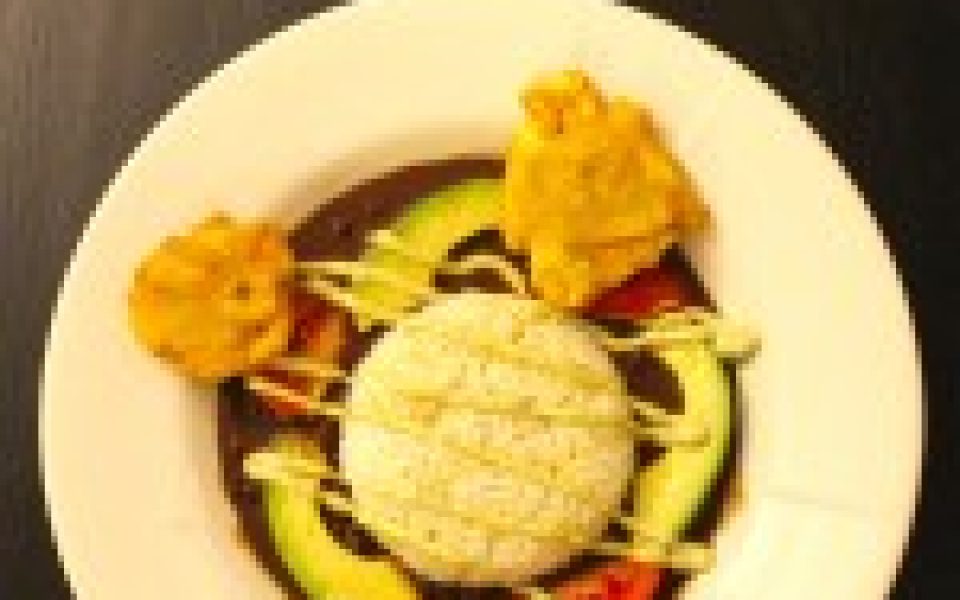by Eric Ginsburg
I implore you to try ropa vieja. Allow me to explain.
Ropa vieja, literally “old clothes” in Spanish, is stewed beef with veggies named for the colorful and, yes, soggy look. But as unappealing as that may sound, this slow cooked dish — usually with pepper, onion, a dash of cumin and garlic and a tomato sauce base — is marvelously flavorful. Follow a basic recipe and spoon it on top of some white rice, and you’ll have a straightforward family classic.
A few nights ago, curious about the offerings at the relocated and recently reopened Miami restaurant near downtown Winston-Salem, my girlfriend and I slipped into the Cuban-centric Caribbean venue. We quickly agreed that the ropa vieja, listed first on the menu, should be one of the things we tried.

©
The Cuban dish may not be much to look at — at least not compared to the colorful bowl of rice, beans, avocado slices, tomato and tostones drizzled with fresh cilantro lime and avocado aioli recommended by our server — but this classic is among the most fundamental and delicious the world can offer. And Miami’s version delivers.
Served with a mound of white rice and accompanied by a small bowl of beans, the ropa vieja is an unassuming star. Looking at the stringy beef we splayed inartistically across the rice, it would be easy to underestimate it as basic.
How wrong you would be.
The meal, which is cheaper during lunchtime, comes with a side, and we chose wisely again adding sweet plantains, a counterpoint to the savory, heartwarming nature of the Cuban cuisine. With browned skin and blackened tips, the sweet plantains tasted every bit as good as their counterparts I’ve tried throughout Central America.
I don’t mean to imply that we didn’t enjoy the rest of our meal; we shared the ropa vieja and the recommended Cuban bowl, adding masitas de puerco — fried pork chunks that arrived with onion — and liked all of it. The relatively dry tostones, or fried plantain patties, and toughened pork added some appreciated texture and balance to the bowl. Bites with avocado, tostone and the rice-and-bean mixture were particularly enjoyable.
At the table next to us, a couple conversed in Spanish, breaking to answer our waiter’s inquiry about the tripleta sandwich: “Awesome,” the woman replied. Next time, I thought, I’d try the steak, roasted pork and ham sandwich on French bread, likely similar to one I’d recommend from Empanadas Borinquen, a Puerto Rican food truck based in Greensboro. Either that or the Cubano, obviously, though both strike me as more appropriate speedy lunch cuisine.
Miami is not without its drawbacks. Given that it’s called Miami Restaurant & Bar, it’s a little hard to understand why there aren’t any adult drinks — at least not yet, but they’re coming, our server assured us. The restaurant’s new, current location at the corner of Brookstown and Broad seems a strange choice, occupying a sort of obscure location.
Pulling off the conversion of the residential structure into a restaurant requires some buy-in from patrons, who are separated into three rooms out of sight of each other. The place is a maze, our server admitted, offering to lead us to the bathroom when asked about its whereabouts because it required four turns and ascending a few stairs.
It’s the kind of quirk that I found amusing, although a little distracting on the first trip, but that my vivacious grandmother with socialite tendencies might not tolerate. The only part that really lost me was the flag in the men’s restroom, which I mentally likened to Lebanon before going home and researching it and discovering the red flag with a white square and green tree is associated with the New England Revolution men’s soccer team.
 But as random as the flag and building may feel, the cuisine, as far as we could tell, more than holds up its end of the bargain. Throw an Iron Beer — a non-alcoholic soda on the menu that tasted like a cross between root beer and cream soda — and solid service into the mix, and there’s more than enough reason to overlook any shortcomings.
But as random as the flag and building may feel, the cuisine, as far as we could tell, more than holds up its end of the bargain. Throw an Iron Beer — a non-alcoholic soda on the menu that tasted like a cross between root beer and cream soda — and solid service into the mix, and there’s more than enough reason to overlook any shortcomings.
Miami offers other Caribbean fare available at places such as local Dominican restaurant Mangu Bar & Grill, including bistec encebollado and mofongo. And it serves the intriguing lechon asado — slow roasted pork “with our special mojito sauce” and sautéed onions — as well. Tempting as any of these may be, I encourage you to start at the beginning and treat yourself to the satisfying Cuban hallmark that is ropa vieja.
Visit Miami Restaurant & Bar at 712 Brookstown Ave. (W-S) or find it on Facebook.
Join the First Amendment Society, a membership that goes directly to funding TCB‘s newsroom.
We believe that reporting can save the world.
The TCB First Amendment Society recognizes the vital role of a free, unfettered press with a bundling of local experiences designed to build community, and unique engagements with our newsroom that will help you understand, and shape, local journalism’s critical role in uplifting the people in our cities.
All revenue goes directly into the newsroom as reporters’ salaries and freelance commissions.


Leave a Reply